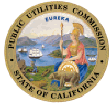 California Public Utilities Commission
California Public Utilities Commission
505 Van Ness Ave., San Francisco
_________________________________________________________________________________
FOR IMMEDIATE RELEASE PRESS RELEASE Media Contact: Terrie Prosper, 415.703.1366, news@cpuc.ca.gov Docket #: R.10-05-004
CPUC IMPROVES AND STREAMLINES
SELF-GENERATION INCENTIVE PROGRAM
SAN FRANCISCO, September 8, 2011 - The California Public Utilities Commission (CPUC) today improved and streamlined its Self-Generation Incentive Program (SGIP), including modifying eligibility criteria and incentive amounts and payment structures for eligible technologies.
Eligibility for participation in the SGIP will now be based on greenhouse gas (GHG) emissions reductions. Technologies that achieve reductions of GHG emissions will be eligible for the program, including wind turbines, fuel cells, organic rankine cycle/waste heat capture, pressure reduction turbines, advanced energy storage, and combined heat and power gas turbines, micro-turbines, and internal combustion engines..
Participants will receive up-front and performance-based incentives (PBI). The incentives will apply only to the portion of the generation that serves a project's on-site electric load.
CPUC President Michael R. Peevey, a long-time advocate for renewable and clean energy said, "Today's decision represents a team effort between the California Air Resources Board and the CPUC as we strive to reach goals of achieving 33 percent renewable energy by 2020 and reduction of greenhouse gas emissions to 1990 levels by 2020. It is wise to look at renewable energy not only as a means to reduce the need for construction of additional power plants but also a means to reduce our greenhouse gas emissions."
Said Commissioner Timothy Alan Simon, "Today's decision will further incentivize and advance the development of small-scale generators in California while integrating the state's goal of reducing greenhouse gas emissions. The decision has identified several proactive steps that demonstrate high priority and promote small generators."
Added Commissioner Catherine J.K. Sandoval, "This newly revised program will help our people and planet by reducing greenhouse gas emissions, decreasing demand on the electric grid, promoting innovation, and providing customers new options for their power needs."
Today's changes in the SGIP will apply only to projects going forward. Existing SGIP projects will continue to receive the same incentives they were receiving prior to today's decision and will continue to operate under the existing SGIP rules. Eligible projects that were completed between January 1, 2011, and the effective date of today's decision will be subject to the program rules that were in place during that time.
The SGIP was established in 2001 as a peak-load reduction program seeking to encourage the development and commercialization of new distributed generation - generation installed on the customer's side of the utility meter. Incentive payments to SGIP participants benefit all ratepayers by reducing the need for utilities to invest in expensive transmission and distribution infrastructure. Today's decision, through Senate Bill 412, also extends the SGIP from January 1, 2012, to January 1, 2016.
The program is available to customers of Pacific Gas and Electric Company, Southern California Edison, Southern California Gas Company, and San Diego Gas & Electric.
For more information on the CPUC, please visit www.cpuc.ca.gov.
###
